· Connor Lopez · Tutorials · 3 min read
Loyalty Program: Why Stamps And Why 10?

Chances are you’ve got a loyalty stamp card tucked away in your wallet or stashed in one of your apps. It’s hard to think of a coffee shop or any service-based business that doesn’t offer a stamp-based loyalty program these days.
But doesn’t it remind you a bit of the 10,000 steps a day trend that everyone jumped on, only to discover it was more myth than science?
Not to say that stamp collection is a scam, but why the fixation on 10 stamps, and why stamps in the first place? What’s the reasoning behind these unwritten rules? Surely, there are more imaginative and creative ways.
It seems that the trend of stamp collecting loyalty programs has emerged because, in this fast-paced, digitally innovative age, keeping up can be a challenge. Especially on the marketing front, businesses that struggle in this arena may feel compelled to do something to stay in the game. Imagine you run a coffee shop, and three of your local competitors just introduced stamp collection loyalty programs. Would you feel pressured to do the same?
When you think about it, a stamp collection program does make logical sense. Frequent customers earn their 10th item for free—it’s straightforward. Now, there are apps that have digitized the whole stamp collection process, but in doing so, they’ve made the whole process of launching the program more complicated. But with this added complexity comes a critical question: is it worth it?
Most, if not all, of these apps that digitize stamp cards don’t provide significantly more customer data. And even if they do, it’s usually not groundbreaking information that could revolutionize your business strategies. As for physical cards, are they genuinely useful? You can hand them out, sure, but tracking any meaningful information or data is nearly impossible.
But what if we consider this stamp collecting program from the customer’s perspective? Let’s be real, most people never make it past 3 stamps, and these cards often end up in the recycling bin. Of course, there are truly loyal customers who are the exception, but this also makes sense. Stamp collecting lacks instant gratification; the rewards are long-term, almost too long-term. Some apps try to offer perks in smaller doses, like a 20% discount on the third visit or a free glass of wine on the fifth. Sounds good from a business perspective, right? However, it may hold little to no value for the customer. Think about it—20% off a $3 coffee? Really? And what if the customer doesn’t drink wine, is underage, or pregnant?
As everyone knows by now, people are driven by emotions and crave instant gratification. That’s the secret sauce behind the popularity of TikTok—short, snappy content that caters to our fleeting attention spans. Most purchases people make are emotionally driven, especially in the realm of shopping. So, despite its flaws, the popularity of the stamp collection program underscores the clear gap between businesses and customers, a gap that needs to be addressed and bridged. It’s natural for business owners to follow trends because the fear of falling behind is real. But fear shouldn’t lead to irrational decisions; we must remember to look at potential solutions from the customer’s perspective. What truly piques their interest? How can we find mutually beneficial solutions?
Don’t worry; we get it, and that’s exactly why Dozo came into existence.



